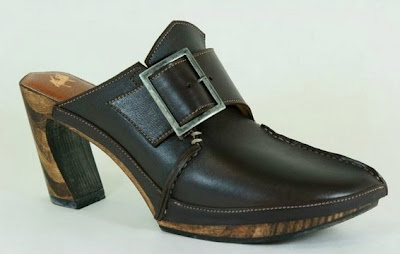Q: What do you think of clogs (as in, on me)? I know they're one of this season's trends, but should I? Good idea? Bad idea?
 (Fashion Monday audio here or read on!)
(Fashion Monday audio here or read on!)If it's about "BUY OR DON’T BUY?" I say it’s a buy.
I spoke with Wendy de Kruyff, owner of Dream Apparel in Vancouver. Wendy says most women are wearing clogs in Vancouver as a mix of both fashion shoe and a comfort shoe.
Wendy says she’s seeing this season with skinny jeans. And as I was speaking with her, a customer walked in with clogs with wide leg pants. In other words, it’s a versatile shoe.
Because it’s a natural shoe with a wood sole, it’s good too keep things natural and fresh above it. Shiny black leggings may not work for most.
Jenna (who is a co-worker and posed the question) is a perfect person to show a lot of leg, up to mid-thigh.
Overall, I really like the look with a simple summer dress. Consider seersucker or chambray. Vancouver designer Allison Smith of Allison Wonderland came out with short shirt dresses in chambray. It would be lovely with clogs and it's on sale at Dream for $150.
BUYING GUIDE:Clogs are made out of wood. They don't change shape and they certainly don't bend. To get good value out of your clogs make sure the FOOTBED, the ROLL, and the INSTEP fit you!
FOOTBED is the part where you feet touches the wood or the lining
on the wooden sole. Ken Rice, master shoemaker, says a good footbed provides arch support.Because wood soles are static, nothing is going to move. The fit won’t change, if the footbed is not snug and the balls of your feet and the arch aren’t in the right place, you will not feel comfortable.At the toe, one should look for no more than an half-inch of toe space. With a custom pair it can go down to just under a quarter inch.Of course, both your heel and toe should be inside the footprint. Rice says overhang is just "dreadful."
ROLL is an important aspect of a well-designed clog. It’s the leading edge of the bottom of the shoe. It has to have the right curve or bevel to match your gait.When you take a step forward, your wooden sole has to rock forward because it can't bend. Low heeled clogs need deeper rolls. High heels need less roll.A simpler way to understand this is clogs need to be shaped to give you a normal heel to toe action. The rule of thumb is the clog should matche the way YOU walk. You don’t change the way you walk to fit the clog.
INSTEP is all important if you want the clogs to stay on your feet. The instep is the part of your foot where your laces would go.
Insteps matter because your heel lifts off the back in traditional clogs. At that point the only part holding your feet to the clogs is the instep.Ken says, this is the only part of the shoe that will stretch so the correct fit is vital. If it’s too loose you will either bend or curl your toes to raise your instep to keep the clogs in contact with your feet. If you have to do that, that’s a bad fit.
Remember, you shouldn't have to alter your stride or the way you hold your feet to
keep clogs on.
Comments
Post a Comment